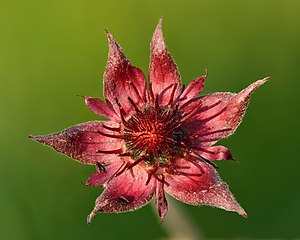Comarum palustre: Difference between revisions
From LSJ
Θάλασσα καὶ πῦρ καὶ γυνὴ τρίτον κακόν → Tria magna mala sunt: aequor, ignis, femina → Das dritte Übel ist nach Meer und Brand die Frau
(Created page with "==Wikipedia EN== thumb|Comarum palustre|alt=Comarum palustre - Niitvälja bog.jpg Comarum palustre (syn. Potentilla palustris),...") |
m (Text replacement - "(?s)(==Wikipedia EN==)(\n)(.*$)" to "{{wkpen |wketx=$3 }}") |
||
| Line 1: | Line 1: | ||
= | {{wkpen | ||
[[File:Comarum palustre - Niitvälja bog.jpg|thumb|Comarum palustre|alt=Comarum palustre - Niitvälja bog.jpg]] | |wketx=[[File:Comarum palustre - Niitvälja bog.jpg|thumb|Comarum palustre|alt=Comarum palustre - Niitvälja bog.jpg]] | ||
Comarum palustre (syn. Potentilla palustris), known by the common names purple marshlocks, swamp cinquefoil and marsh cinquefoil, is a common waterside shrub. It has a circumboreal distribution, occurring throughout North America, Europe, and Asia, particularly the northern regions. It is most commonly found on lake shores, marshy riversides and stream margins, often partly submerged with foliage floating. It is a parent of some Fragaria–Comarum hybrids, ornamental plants produced by crossing with strawberries. | Comarum palustre (syn. Potentilla palustris), known by the common names purple marshlocks, swamp cinquefoil and marsh cinquefoil, is a common waterside shrub. It has a circumboreal distribution, occurring throughout North America, Europe, and Asia, particularly the northern regions. It is most commonly found on lake shores, marshy riversides and stream margins, often partly submerged with foliage floating. It is a parent of some Fragaria–Comarum hybrids, ornamental plants produced by crossing with strawberries. | ||
}} | |||
Latest revision as of 12:45, 24 October 2022
Wikipedia EN
Comarum palustre (syn. Potentilla palustris), known by the common names purple marshlocks, swamp cinquefoil and marsh cinquefoil, is a common waterside shrub. It has a circumboreal distribution, occurring throughout North America, Europe, and Asia, particularly the northern regions. It is most commonly found on lake shores, marshy riversides and stream margins, often partly submerged with foliage floating. It is a parent of some Fragaria–Comarum hybrids, ornamental plants produced by crossing with strawberries.

